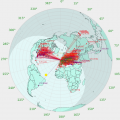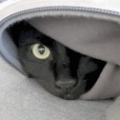The KiwiSDR 2 online store is open for orders! Please visit kiwisdr.nz
Please visit kiwisdr.com (documentation) and kiwisdr.nz (online store)
G8JNJ
About
- Username
- G8JNJ
- Joined
- Visits
- 3,720
- Last Active
- Roles
- Member
- Points
- 16
Reactions
-
v1.360+: DRM extension now available
Hi John & All Happy New Year to everyone.
Even if it's not possible to decode DRM because the KiWI is occupied, could it be made so that you can still open up the DRM schedule screen so that you can select and tune to stations to see if they are transmitting DRM, even if it's not possible to decode it at the time ?
Also if the DRM extension is selected but the KiWi is occupied, could the DRM extension wait and reserve a slot, but start working when the KiWi has become clear for use ?
Regards,
Martin - G8JNJ -
Using WSPR data to compare antennas
Hi All,
Based on Stu's comments in another thread
>
>If you did make a database one thing I'd really like is the ability to run two or more systems and break down which works better on a band.
>
I thought it may be useful to outline he processes I use to make antenna measurements with WSPR and other similar methods that make use of KiWi web sdr's.
First using WSPR.
WSPR does not report received signal level, but the signal to noise ratio of an individual WSPR transmission as received at the reporting station.
Individual reporting stations will have differing S/N ratios, depending upon the location, antenna, receiver and frequency in use. They also have different propagation paths from the transmitting station.
Therefore you can only compare 'like with like' and derive a delta, not an absolute value.
In order to be able to do this a minimum of two stations are required, which can either be two (or more) transmitting stations as received by one reporting station e.g. one transmit location with two separate antennas and transmitters, or one transmitting station as received by two (or more) reporting stations e.g. one receive location with two separate antennas and receivers.
To be valid data points, the sets of reports being analysed have to be contained within the same two minute time window as each other.
In order to minimise 'outlying' data points it's good practice to be able to exclude S/N values that are outside certain limits. e.g above +10dB as many receive systems compress above this value and also below -25dB as random noise badly distorts the reported value when it becomes closer to the system detection threshold of around -30dB.
WSPR only reports in 1dB steps, so this limits the absolute accuracy that can be obtained. However it is possible to interpolate by using methods such as curve fitting. e.g. plot the distribution of spots for one transmission as received by one reporter. These could be visualised as a horizontal axis of S/N values with 35 vertical bars representing -25dB to +10dB and the vertical axis representing the number of spots of that particular value were reported. If a curve is then 'fitted' to the distribution of the bars, and the peak of the curve is found on the horizontal axis, then the averaged value to sub dB accuracy can be derived.
This is why I like to transmit at 100% duty cycle, as I have often noticed that some spotting stations have a cyclic variation in reported S/N values, when another local WSPR station transmits during one of the receive time slots and either de-sensitises the receiver or operates the receiver AGC, both of which produce a variation in the reported S/N ratio during that time slot. This can be seen as two or more distinct peaks in the distribution curve. In which case either the complete data set can be discarded or the lower sets of values ignored, although this will still slew the results slightly, and should only be used if you are really desperate.
If the curve is not very precise or flat, then either there are not enough spots, or there is too much variation in S/N values and the data sets should be discarded.
The derived S/N values can then be compared against each other and another delta bar graph histogram can be produced and curve plotted to derive a final result.
If this process is repeated for a number of time slots, sets of stations and different bearings, it is possible to produce a polar plot scattergram, showing the differences between two (or more) different antennas.
However as you can imagine all of this is very time consuming to perform manually and it is just crying out for some sort of automated process to be implemented. Something like the WSPRLite system which is a subscription service.
https://www.dxplorer.net/wsprlite/
The sequence I follow to measure the delta between two transmit antennas is as follows:-
Setup two transmitters with different callsigns, each one on a different antenna.
I usually use a vertical 1/4 wave as the 'reference' antenna, as this is omni-directional and easy to model. The other antenna and transmitter is the one 'under test'.
Transmit on one band for 1 hour at 100% ratio, so that I can quickly collect lots of spots, in all the time slots, before the propagation changes too significantly to distort the results.
It's best to do this mid morning or mid afternoon so that grey line and other relatively rapid propagation changes are not occurring.
Collect the hours worth of spots from WSPRNET, discard any reports above +10dB or below -25dB, match signals into the same time slots, discard any sets of signals that do not have a full set of reports in each time slot e.g. only one station reported.
Plot distribution bargraph and curve fit to find average S/N value for each station and reporter pair.
Compare average S/N value for transmitter 1 and transmitter 2 and calculate difference. If there are many reporting stations, plot distribution bargraph of delta S/N values and curve fit to find sub dB average value for each reporting 'pair'.
Use bearing information to produce polar plot scattergram, showing differences in radiation pattern.
The process of comparing two receive antennas is very similar, just substitute the word receiver for transmitter in the above example.
I also use a similar process by comparing signal strengths, but I have to do this manually by comparing KiWi signal strength graphs whilst monitoring plain carriers from two transmitters, if comparing transmit antennas, or AM broadcast stations, if comparing receive antennas.
I usually plot these consecutively over a 2 minute period and note the maximum signal level during that period. This has to be done by 'eyeballing' the graph, which is not as accurate as would be desired as the scaling is in 10dB intervals and it's not currently possible to download the data for off-line analysis in the form of a .csv or .txt file. Although it may be possible to use kiwirecorder.py to perform this function. Once again the manual analysis is very laborious and time consuming.
I hope this provides some 'food for thought' and that it would be possible to provide an alternative to the WSPRNET database which is creaking under the strain, and in addition be able to provide more useful on-line analysis tools that would be of great benefit to the community.
Regards,
Martin - G8JNJ -
Using WSPR data to compare antennas
Hi All,
Based on Stu's comments in another thread
>
>If you did make a database one thing I'd really like is the ability to run two or more systems and break down which works better on a band.
>
I thought it may be useful to outline he processes I use to make antenna measurements with WSPR and other similar methods that make use of KiWi web sdr's.
First using WSPR.
WSPR does not report received signal level, but the signal to noise ratio of an individual WSPR transmission as received at the reporting station.
Individual reporting stations will have differing S/N ratios, depending upon the location, antenna, receiver and frequency in use. They also have different propagation paths from the transmitting station.
Therefore you can only compare 'like with like' and derive a delta, not an absolute value.
In order to be able to do this a minimum of two stations are required, which can either be two (or more) transmitting stations as received by one reporting station e.g. one transmit location with two separate antennas and transmitters, or one transmitting station as received by two (or more) reporting stations e.g. one receive location with two separate antennas and receivers.
To be valid data points, the sets of reports being analysed have to be contained within the same two minute time window as each other.
In order to minimise 'outlying' data points it's good practice to be able to exclude S/N values that are outside certain limits. e.g above +10dB as many receive systems compress above this value and also below -25dB as random noise badly distorts the reported value when it becomes closer to the system detection threshold of around -30dB.
WSPR only reports in 1dB steps, so this limits the absolute accuracy that can be obtained. However it is possible to interpolate by using methods such as curve fitting. e.g. plot the distribution of spots for one transmission as received by one reporter. These could be visualised as a horizontal axis of S/N values with 35 vertical bars representing -25dB to +10dB and the vertical axis representing the number of spots of that particular value were reported. If a curve is then 'fitted' to the distribution of the bars, and the peak of the curve is found on the horizontal axis, then the averaged value to sub dB accuracy can be derived.
This is why I like to transmit at 100% duty cycle, as I have often noticed that some spotting stations have a cyclic variation in reported S/N values, when another local WSPR station transmits during one of the receive time slots and either de-sensitises the receiver or operates the receiver AGC, both of which produce a variation in the reported S/N ratio during that time slot. This can be seen as two or more distinct peaks in the distribution curve. In which case either the complete data set can be discarded or the lower sets of values ignored, although this will still slew the results slightly, and should only be used if you are really desperate.
If the curve is not very precise or flat, then either there are not enough spots, or there is too much variation in S/N values and the data sets should be discarded.
The derived S/N values can then be compared against each other and another delta bar graph histogram can be produced and curve plotted to derive a final result.
If this process is repeated for a number of time slots, sets of stations and different bearings, it is possible to produce a polar plot scattergram, showing the differences between two (or more) different antennas.
However as you can imagine all of this is very time consuming to perform manually and it is just crying out for some sort of automated process to be implemented. Something like the WSPRLite system which is a subscription service.
https://www.dxplorer.net/wsprlite/
The sequence I follow to measure the delta between two transmit antennas is as follows:-
Setup two transmitters with different callsigns, each one on a different antenna.
I usually use a vertical 1/4 wave as the 'reference' antenna, as this is omni-directional and easy to model. The other antenna and transmitter is the one 'under test'.
Transmit on one band for 1 hour at 100% ratio, so that I can quickly collect lots of spots, in all the time slots, before the propagation changes too significantly to distort the results.
It's best to do this mid morning or mid afternoon so that grey line and other relatively rapid propagation changes are not occurring.
Collect the hours worth of spots from WSPRNET, discard any reports above +10dB or below -25dB, match signals into the same time slots, discard any sets of signals that do not have a full set of reports in each time slot e.g. only one station reported.
Plot distribution bargraph and curve fit to find average S/N value for each station and reporter pair.
Compare average S/N value for transmitter 1 and transmitter 2 and calculate difference. If there are many reporting stations, plot distribution bargraph of delta S/N values and curve fit to find sub dB average value for each reporting 'pair'.
Use bearing information to produce polar plot scattergram, showing differences in radiation pattern.
The process of comparing two receive antennas is very similar, just substitute the word receiver for transmitter in the above example.
I also use a similar process by comparing signal strengths, but I have to do this manually by comparing KiWi signal strength graphs whilst monitoring plain carriers from two transmitters, if comparing transmit antennas, or AM broadcast stations, if comparing receive antennas.
I usually plot these consecutively over a 2 minute period and note the maximum signal level during that period. This has to be done by 'eyeballing' the graph, which is not as accurate as would be desired as the scaling is in 10dB intervals and it's not currently possible to download the data for off-line analysis in the form of a .csv or .txt file. Although it may be possible to use kiwirecorder.py to perform this function. Once again the manual analysis is very laborious and time consuming.
I hope this provides some 'food for thought' and that it would be possible to provide an alternative to the WSPRNET database which is creaking under the strain, and in addition be able to provide more useful on-line analysis tools that would be of great benefit to the community.
Regards,
Martin - G8JNJ -
Antenna recommendation for listening to faraway DRM broadcast inside a city
Hi All,
Well the MLA-30 'sort of works' and it doesn't cost very much, so it's better than nothing for folks who don't want to build their own.
You get quite a bit for your money, and it's OK for use with say and RTL dongle in direct sampling mode, but I'll probably cry the first time I see one being used with a high end receiver like a Perseus or Airspy HF :-(
Here are some measured parameters of various popular loops using the same test setup.
MLA-30 OIP2 approx +46dBm OIP3 approx +20dBm
M0AYF OIP2 approx +75dBm OIP3 approx +27dBm
Wellgood (Copy of early Wellbrook) OIP2 approx +57dBm OIP3 approx +37dBm
LZ1AQ OIP2 approx +79dBm OIP3 approx +36dBm
I've now added the MLA-30 information, including circuit diagrams to my Active antennas webpage.
https://www.g8jnj.net/activeantennas.htm#MLA30
Regards,
Martin - G8JNJ -
Need to attenuate LW 252 Khz
>
> found that the notch was 34 dB deep, which was more than necessary. I 'softened' it to 20 dB with a series 2.2 ohm resistor.
>
Hi Richard,
That's good, you must have found an inductor with a good value of Q.
I've only ever been able to achieve a maximum of about 20dB using surface mount or small molded axial types.
You can widen or narrow the notch bandwidth by choosing different L/C ratios. The values I used were designed to provide some attenuation over the whole of the LW BC band, with a deep notch at the band center and minimal effect outside of the band (148-284KHz @ -3dB).
You can decrease the depth of the notch by adding low value series resistors as Richard suggests. When using surface mount inductors, I typically add 6.8 Ohms to this circuit to obtain a notch depth of 10dB, with 0 Ohms I can get about 17 to 20dB.
Here's a plot showing the measured performance of my BC band filters.
Regards,
Martin - G8JNJ






